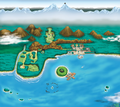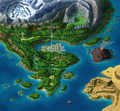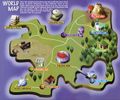Region
- If you were looking for the regions used for region-locking, see Software region.

A region (Japanese: 地方 region) is an organized area of the Pokémon world. There are at most eighteen known regions that have appeared in the various Pokémon canons.
Terminology
This is written as "Region" (starting with a capital letter) in Hidenori Kusaka's message from Pokémon Adventures volume 22:
- "The fourth Pokémon Adventures story arc ends here, but the Hoenn Region will reappear in other major stories in the future."
In the core series games
Nine regions have appeared in the core series of Pokémon games. They are, in order of appearance: Kanto, Johto, Hoenn, Sinnoh (formerly known as Hisui), Unova, Kalos, Alola, Galar, and Paldea. Each region has been the setting of at least two games in the generation in which it debuts.
Most regions are structured similarly. Typically, a region has its own Pokémon League, which includes eight Gym Leaders. Once these eight are defeated, Pokémon Trainers can challenge the regional Elite Four and Champion (except Johto, which shares the Indigo League with Kanto). Alola does not have Gyms but instead hosts the island challenge and only recently created a Pokémon League. Hisui does not have a League, due to it being set in a time where the concept of Pokémon Leagues didn't exist yet. Each region also has a Pokémon Professor who teaches new Trainers about Pokémon and typically gives out starter Pokémon to them. There is usually a villainous team operating within the region that uses Pokémon to further its goals.
Though there are many similarities between them, there are some major differences between the regions, such as which Pokémon can be found and where various legends originate from. Visitors from another region quickly realize that the region they are visiting is far from their home, as noticeable by the distance traveled and the differences in climate, location, and the local culture.
In Diamond, Pearl, and Platinum, Professor Oak explains that Sinnoh, Kanto, and Hoenn are part of a larger country, whose name has yet to be revealed.[1] Due to Johto being Kanto's neighboring region, it could be assumed that Johto is also a part of this country. This concept is similar to the regions of Japan, which the Pokémon world has been modeled after, and from which the Pokémon world's Kanto region takes its name. Unova, Kalos, Alola, Galar and Paldea are known to be located far away from Kanto and Johto, and as such may not be part of this country. Additionally, Kitakami is stated to be in the East. Malie City in the Alola region was built by people who previously lived in Kanto and Johto and is also stated to have Eastern influence. The midway between Johto and Sinnoh/Hisui lies the Sinjoh Ruins, being described as an entire location in Old Verse 12.
Other locations
There are similar places in the Pokémon world which are technically not called "regions", but share similarities in terms of in-game mechanics with regions, some of which even have their own regional Pokédexes. Examples include the Sevii Islands, the Isle of Armor, the Crown Tundra, and Kitakami (officially referred to as "the land of Kitakami").
The Sevii Islands are located south of the Kanto region. The Isle of Armor and the Crown Tundra are part of the Galar region. The land of Kitakami is mentioned to be located in the East and is far enough from Paldea that traveling to it from there requires both a plane and a bus.
Unnamed locations
Many locations go unnamed. These locations can be other regions that certain Pokémon may have originated from, or locations described with an unknown origin or description.
- Pokédex entries and biology
- Alolan Rattata are confirmed to not be native to Alola and arrived from somewhere else in cargo ships.[citation needed]
- Yungoos's Pokédex entry in Pokémon Sun and Gumshoos's entry in Pokémon Ultra Sun reveal that they did not originally live in Alola and were imported from another region.[2][3]
- Corphish's Pokédex entries in Pokémon Ruby and Omega Ruby reveal that it was originally a foreign Pokémon that was imported to Hoenn as a pet.[4]
- Exeggutor's Pokédex entries in Pokémon Ruby, Sapphire, Emerald, Omega Ruby, and Alpha Sapphire reveal that it originally lived in the tropics.[5][6]
- Gible's Pokédex entries in Pokémon Pearl and Shining Pearl reveal that it once lived in the tropics. [7]. Its Pokédex entry in Ultra Moon reveals that Gible's original home is much hotter than Alola.[8]
- The home of the Ultra Beast Guzzlord, Ultra Ruin, appears to be an alternate universe's version of the Alola region.[9]
- Gigantamax Melmetal's Pokédex entry in Pokémon Sword reveals that there are legends of a cyclopic giant, a Gigantamaxed Melmetal, in a distant land.[10]
- Copperajah's Pokédex entry in Pokémon Sword reveals that it came from another region to work with humans in Galar.[11] Its Pokédex entry in Pokémon Scarlet reveals that it was brought to Paldea from a different region, which may or may not be the same as the one mentioned in its Pokémon Sword entry.[12]
- Single Strike Style Urshifu's Pokédex entry in Pokémon Shield reveals that it lives in the mountains of a distant region.[13]
- Quaxly's Pokédex entry in Pokémon Scarlet reveals that it migrated to Paldea from a different region.[14]
- Other mentions
- In Old Verse 12, a place named Sinjoh is mentioned, likely where the ruins of same name are located, somewhere around the Johto and Sinnoh regions.[15]
- In the Treasures of Ruin's story told by Raifort, it's revealed the cursed treasures originated from a distant land in the east of Paldea, brought to Paldea by a merchant and purchased by the Paldean king.[16]
- In Ogerpon's backstory, as told by Kieran and Carmine's grandfather, it's revealed both Ogerpon and her friend came from a foreign land.[17] The backstory also reveals that the Loyal Three also came to Kitakami from somewhere else.[18]
Gallery
- List of regions
- LGPE Kanto Map.png
- Other locations
Kitakami in Pokémon Scarlet and Violet: The Hidden Treasure of Area Zero
In the side series games
The region of the Generation III side series games, Pokémon Colosseum and Pokémon XD: Gale of Darkness, Orre has similar characteristics to the core series regions but lacks some basic core series features. There are mostly Pokémon Trainers inhabiting the region. There are very few settlements and no routes. There is no official Pokémon League, but rather a variety of facilities which offer consecutive battles. There is a regional professor, Professor Krane and regional villains, Cipher and Team Snagem. Wild Pokémon only appear in rare areas called Poké Spots.
Art
In the spin-off games
Pokémon Ranger series
In the Pokémon Ranger series, the regions of Fiore, Almia, and Oblivia are much smaller and have different cultures than the core series regions. Pokémon Trainers are not present in the regions. Pokémon are not kept inside Poké Balls and wild Pokémon can be seen wandering cities as well as routes. Pokémon Rangers act as authority, helping Pokémon and people in need. There are no individual Gyms, an Elite Four or a Champion. However, Rangers can take the Capture Challenge to test their skills. Despite their peaceful natures, there are villainous teams that operate within both regions that capture and use Pokémon to further their goals of world domination. One such villainous team has been known to brainwash Pokémon using their advanced technology, causing them to lose their memories and wreak havoc. There is an associated federation similar to the Ranger Union in Fiore and Almia that organizes all activities for rescue and exploration teams.
Pokémon Mystery Dungeon series
The Pokémon Mystery Dungeon series takes place in a world that is populated solely by Pokémon; humans do not live there. The world has six continents, with many Pokémon found in dungeons, but also towns in which Pokémon live, including Pokémon Square, Treasure Town, Post Town, and Lively Town. Some of the Pokémon within them form exploration teams that explore dungeons and help Pokémon in need. The Wigglytuff Guild is where beginning exploration teams live and learn the basics, while the Expedition Society serves a similar role for expedition teams. The Makuhita and Marowak Dojos are places somewhat similar to Gyms in the main regions where exploration teams hone their skills.
Other games
Holon, Parallel Worlds, and the Trading Card Game Islands appear in the Pokémon Trading Card Game and the eponymous video games. The relationship of these regions with the others is unclear.
Pokémon Snap is set on Pokémon Island, an isolated reserve home to many species of Pokémon. It appears to have a relationship with the Kanto region of the core series, as Professor Oak appears to have some authority over the island.
Pokémon Channel is set in Mintale Town, which is inhabited by many species of Pokémon. Humans may live there too; there is at least one suburban area.
Pokémon Conquest takes place in the Ransei region, which is said to have been created by Arceus and is divided into 17 kingdoms, each ruled by a different warlord.
Pokémon Trozei! is set in an unnamed area. Its sequel Pokémon Battle Trozei takes place in an unnamed island divided into zones.
Pokkén Tournament takes place in the Ferrum region, which seems to be located somewhere in the core series Pokémon world, as Cinnabar Island is mentioned in the game.
Pokémon Duel takes place on Carmonte Island, an artificial resort island filled with luxury hotels.
Detective Pikachu and its sequel's main setting is Ryme City, a big city where people and Pokémon live together. It has some kind of connections to the core series regions, as regional forms are both mentioned and shown to exist in these games, and Tim's notes on Alolan Rattata mention the Alola region.
Pokémon Quest takes place on Tumblecube Island, which is inhabitited by numerous cube-shaped Pokémon. It seems to have connections to the core series Pokémon world, as the Silph Co. is mentioned at one point.
Pokémon Masters EX takes place on Pasio, an artificial island built by Lear to host the Pokémon Masters League, in which Trainers from various core series regions compete against each other.
New Pokémon Snap takes place in the Lental region, which is an archipelago housing many different kinds of habitats for wild Pokémon.
Pokémon UNITE takes place on Aeos Island, a mythical, distant island where people use Aeos energy to participate in Unite Battles.
Art
Setting of Pokemon Trozei
Unnamed island in Pokémon Battle Trozei
In the anime
The protagonists of the Pokémon anime, Ash Ketchum and his traveling companions, have visited all eight of the core series regions in the same order the games have been released. To accommodate plots, story arcs, and episode numbers, regions in the anime are much larger than their game counterparts. The regions are also shown to have a number of cities and towns that are not present in the games. In some cases, some areas are moved to a different region from their game counterparts; for example, the Hoenn Battle Frontier in Pokémon Emerald was not in Hoenn in the anime, but instead in Kanto with the different facilities scattered all over the region rather being located on an island. Additionally, Pokémon FireRed and LeafGreen's Sevii Islands appeared in one Pokémon Chronicles episode, The Search for the Legend.
Additionally, two regions exist in the anime that do not exist in any video game:
- Orange Archipelago, the tropical setting for the second season, Adventures in the Orange Islands. Located south of Kanto and Johto, it differs from the standard region formula, with only four Gyms.
- Decolore Islands, the setting of the final arc of Pokémon the Series: Black & White. It is located between Kanto and Unova, and it has no Pokémon Professor, no Pokémon Gyms, no Pokémon League, and no villanous team.
Trivia
- Both anime-exclusive regions are archipelagoes.
- Before Generation VIII, each core series region had the letter 'o' present in its English name (Kanto, Johto, Hoenn, Sinnoh, Unova, Kalos, and Alola). The anime-exclusive regions also have the letter present (Orange Archipelago and Decolore Islands).
- Additionally, six of the seven regions prior to Generation VIII had a name that was five letters long, excluding Sinnoh.
- Sinnoh's former name, Hisui, happens to be five letters long.
- Additionally, six of the seven regions prior to Generation VIII had a name that was five letters long, excluding Sinnoh.
- Out of all of the regions in-game, Kalos has the highest population of 1,288. Kanto has the lowest, with 391 in Generation III and 364 in Generation IV.
In other languages
| ||||||||||||||||||||||||||||||||||||||||||||||||||||||||||||||||||||||||||||||||
References
- ↑ Professor Oak: "... This is Pal Park! Pokémon from around the country can be brought here. In other words, Pokémon from places like Kanto and Hoenn. ..." (Pokémon Diamond, Pearl, and Platinum)
- ↑ Pokédex entry: ... It did not originally live in Alola but was imported from another region. (Pokémon Sun)
- ↑ Pokédex entry: Although it wasn't originally found in Alola, this Pokémon was brought over a long time ago when there was a huge Rattata outbreak. (Pokémon Ultra Sun)
- ↑ Pokédex entry: Corphish were originally foreign Pokémon that were imported as pets. They eventually turned up in the wild. ... (Pokémon Ruby and Omega Ruby)
- ↑ Pokédex entry: Exeggutor originally came from the tropics. ... (Pokémon Ruby, Sapphire, Omega Ruby, and Alpha Sapphire)
- ↑ Pokédex entry: Originally from the tropics, Exeggutor's heads grow larger from exposure to strong sunlight. ... (Pokémon Emerald)
- ↑ Pokédex entry: It once lived in the tropics. ... (Pokémon Pearl and Shining Pearl)
- ↑ Pokédex entry: Its original home is an area much hotter than Alola. ... (Pokémon Ultra Moon)
- ↑ A partially readable sign in Ultra Ruin saying "...oli... ...ity Ha... "Servi... ... ...ity's... ...need..." matches the sign on the Hau'oli City Hall (Hau'oli City Hall - Serving the city's every need!). Other locations are also reminescent of landmarks in Hau'oli City.
- ↑ Pokédex entry: In a distant land, there are legends about a cyclopean giant. In fact, the giant was a Melmetal that was flooded with Gigantamax energy. (Pokémon HOME)
- ↑ Pokédex entry: They came over from another region long ago and worked together with humans. ... (Pokémon Sword)
- ↑ Pokédex entry: This Pokémon was brought to Paldea long ago by people from a faraway land. ... (Pokémon Scarlet)
- ↑ Pokédex entry: Inhabiting the mountains of a distant region, this Pokémon races across sheer cliffs, training its legs and refining its moves. (Pokémon Shield)
- ↑ Pokédex entry: This Pokémon migrated to Paldea from distant lands long ago. ... (Pokémon Scarlet)
- ↑ Old Verse 12: ... Certainly the land of Hisui bears some resemblance to Sinjoh. ... (Pokémon Legends: Arceus)
- ↑ Raifort: History class 4 (Pokémon Scarlet and Violet)
- ↑ Kieran and Carmine's grandfather: ... A long, long time ago, a man and an ogre came to Kitakami from a foreign land. ... (Pokémon Scarlet and Violet - The Hidden Treasure of Area Zero Part 1: The Teal Mask)
- ↑ Kieran and Carmine's grandfather: ... In fact, rumors about [their masks] quickly spread far and wide, even to distant lands. ... A group of greedy Pokémon soon made their way to the land of Kitakami. ... (Pokémon Scarlet and Violet - The Hidden Treasure of Area Zero Part 1: The Teal Mask)
See also
| Regions in the Pokémon world | ||
|---|---|---|
| |||||||||||||||||||||||||

|
This article is part of Project Locations, a Bulbapedia project that aims to write comprehensive articles on every location in the Pokémon world. |
































